There is a common myth that mold is less prevalent during the winter. This comes from the idea that the harsh winter cold air would be inhospitable to mold. However, most of our homes are actually well heated during the winter months. The presence of heated air with the lack of moisture in the air actually can make mold more problematic during the winter months. Mold may continue to grow throughout your home and you may not even be aware of it.
Why Mold Is A Problem
Many homeowners and business owners do not recognize the full extent that mold can be a problem. Aside from ruining expired food or causing strange smells in your home, mold can actually cause some dangerous side effects in people. The majority of mold varieties cause allergy-like symptoms including a weakened respiratory system. This can be especially problematic for people with weak immune systems or difficulty breathing due to chronic conditions including asthma. However, there are some mold varieties that are much more dangerous and can actually cause breathing conditions. Black mold, for instance, has been linked to different breathing conditions.
Mold And Winter Conditions
As mentioned above, winter provides unique conditions for mold growth. Although it is true that mold will not be able to grow outside of a home or business during the harsh winter months, it can still grow inside heated buildings. However, even with the warm air, the lack of moisture in the air changes where mold can grow. During the summer and spring mold most commonly grows in visible areas around your home. Specifically in damp warm and dark areas including basements, kitchens, and bathrooms. But during the winter mold is more commonly going to grow in areas between walls, floors, and ceilings. The drier air forces mold to grow in areas with more trapped moisture. Because you cannot see inside these areas you may not even know that you have a mold issue.
How To Tell If You Have Mold
The most common way to tell if you have mold when there are no mold visible signs of mold in your home or office is smell and symptoms. If people in the building are experiencing similar symptoms to allergies or can smell a mildew or moldy smell coming from certain rooms in the house, it is possible that mold is growing around the plumbing systems that exist in your walls. Because plumbing systems are the only warm area of your home that is consistently providing the moisture mold needs to grow, these are the common areas mold grows in the winter. If you notice mold signs in your home, consider having a professional tester test the air quality of your home for signs of mold spores. Once mold is identified next steps can be taken.
Hire DCM Environmental Testing for Mold Testing
If you need your business or home tested for mold, contact our team online. DCM Environmental can help test your property for mold, asbestos, or lead paint and promptly provide you test results.



